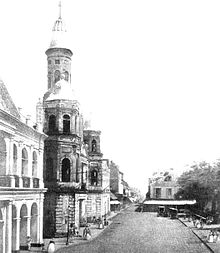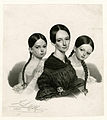Jules Lion

Jules Lion (born 1809 / 1810 in Paris , died 9. January 1866 was) an American lithographer , formerly photographer and painter . He is considered the most important black artist in the New Orleans of the antebellum .
life and work
As early as 1831 and 1836, Lion exhibited lithographs in the Salon de Paris . He published work in L'Artiste magazine and created pictures of the well-known Americans Andrew Jackson and Martin Van Buren . In 1836 or early 1837, Lion emigrated to New Orleans and was hired in a lithography studio for the local New Orleans Bee newspaper . Together with his brother Achille, Jules Lion invested in imported goods, whereby they lost a lot of money due to the financial crisis in 1837 .
1839 Lion was there for a short time back in Paris and learned of Louis Daguerre developed technique of daguerreotype know. He returned to New Orleans and took pictures of the city's landmarks. On March 15, 1840, he put his daguerotypes together for an exhibition in the St. Charles Museum. That same year, Jules Lion opened a studio in New Orleans and provided the city's oldest daguerreotype-making set. After New York, New Orleans was the second city in the United States to have this technology. As a “ mulatto ”, Lion was also probably America's first African-American photographer. After the costs for the photographs and the competition became too high from around 1843, he returned to lithography. In addition to his studio work, he traveled to southern Louisiana and produced portraits in Baton Rouge , Donaldsonville , Opelousas as well as Assumption Parish and St. James Parish . His pictures show numerous prominent people from Louisiana , including John James Audubon and the American President Andrew Jackson .
Andrew Jackson (1840)
He also made lithographs with motifs from New Orleans, such as Canal Street and St. Louis Cathedral . In addition, he gave classes at Louisiana College, the predecessor of the University of Louisiana , which he carried out in part with the muralist Dominique Canova .
In 1860 he revived a project that he had been pursuing since the 1840s. He wanted to publish his pictures in the book Notabilités de la Louisiane , but despite numerous interested parties, he was unable to raise the money to publish the book. With the outbreak of the Civil War in 1861, Lion published cover images for music papers of the Confederate States of America for various publishers, including images of Jefferson Davis , the leader of the Southern United States in the Civil War. Even after the conquest of Louisiana by the Union and until his death on January 9, 1866, he produced more portraits and continued to give art lessons.
supporting documents
- ↑ His date of birth is unknown; according to his obituary, he died at the age of 56. See East, The Georgia Review, Vol. 40, No. 4 (Winter 1986), 913.
- ↑ a b c d e f g Jules Lion ( Memento of the original dated June 6, 2014 in the Internet Archive ) Info: The archive link was inserted automatically and has not yet been checked. Please check the original and archive link according to the instructions and then remove this notice. in the Encyclopedia of Louisiana; Retrieved June 5, 2014.
- ↑ a b Lion, Jules. Entry in Mantle Fielding: Dictionary of American Painters, Sculptors and Engravers. Modern Books and Crafts 1926, enlarged version 1974, ISBN 0-913274-03-8 , p. 217
- ↑ Malcolm Jones: Black On Black. Newsweek, April 23, 2000; Retrieved June 5, 2014.
literature
- Lion, Jules. Entry in Mantle Fielding: Dictionary of American Painters, Sculptors and Engravers. Modern Books and Crafts 1926, enlarged version 1974, ISBN 0-913274-03-8 , p. 217
- Charles East: Jules Lion's New Orleans. In: The Georgia Review. Volume 40, No. 4 (Winter 1986), pp. 913-920.
Web links
| personal data | |
|---|---|
| SURNAME | Lion, Jules |
| BRIEF DESCRIPTION | American lithographer, former photographer and painter based in New Orleans |
| DATE OF BIRTH | around 1809 |
| PLACE OF BIRTH | Paris |
| DATE OF DEATH | January 9, 1866 |



